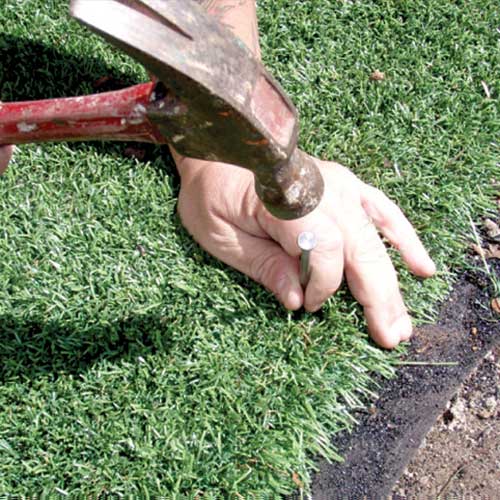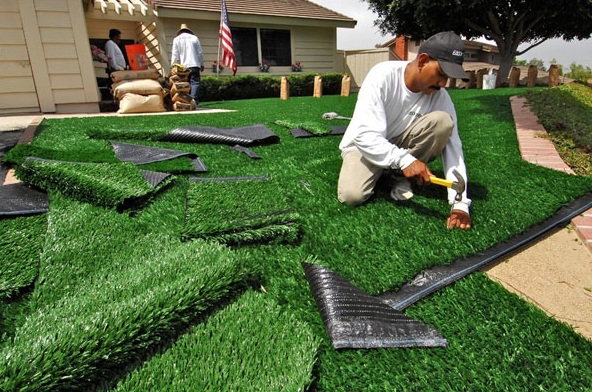High-Quality Arizona Turf Solutions for a Attractive and Lush Landscape
High-Quality Arizona Turf Solutions for a Attractive and Lush Landscape
Blog Article
Explore the Environmental Benefits of Opting for Artificial Turf Solutions
The fostering of artificial grass remedies provides an engaging opportunity to resolve pushing environmental difficulties. By significantly reducing water use and lessening the application of unsafe chemicals, these choices not only advertise sustainable landscaping however likewise secure local communities. The lower carbon impact associated with reduced upkeep tasks adds to a much more sustainable strategy to land administration. The ramifications of these advantages extend past mere conservation efforts, raising questions about their lasting impact on environment conservation and general eco-friendly balance. Exploring these measurements discloses a complex interplay worth thinking about.
Water Conservation Perks
Among the most significant advantages of synthetic grass is its capability to conserve water. Conventional yard lawns need substantial watering, especially in locations prone to drought or water restrictions. In contrast, synthetic grass does not need watering, considerably minimizing the overall demand for water resources. This attribute is specifically useful in arid regions where water shortage is a pressing problem.
By eliminating the demand for regular watering, synthetic grass adds to lasting landscape methods and helps reduce the environmental impact of excessive water consumption. Additionally, the conservation of water reaches the reduction of runoff, which can result in soil disintegration and river contamination.
In addition, the installment of synthetic grass allows districts and home owners to assign water resources more successfully, concentrating on important uses such as alcohol consumption water and farming. The change towards synthetic grass not just promotes liable water usage yet likewise straightens with wider ecological goals aimed at preserving natural deposits.
As communities progressively focus on sustainability, the water conservation benefits of synthetic grass present an engaging instance for its fostering in household and industrial landscaping projects.
Decreased Chemical Use
The transition to artificial lawn considerably lowers the reliance on chemical therapies commonly utilized in natural turf maintenance. Traditional turf management typically involves the application of herbicides, chemicals, and plant foods to advertise development and control bugs. These chemicals can pose risks to human health and wellness, regional wildlife, and the environment, adding to dirt and water contamination.
In contrast, man-made grass eliminates the requirement for these unsafe substances. By lessening the launch of synthetic compounds into the ecological community, fabricated grass promotes healthier dirt and water systems.
In addition, the absence of chemical drainage related to synthetic grass setups assists protect neighborhood waterways from air pollution, supporting aquatic life and keeping biodiversity. Arizona turf. As areas significantly focus on sustainable methods, deciding for artificial turf provides a feasible option that aligns with ecological preservation goals. Via this shift, building owners can appreciate lush green areas without jeopardizing environmental health, paving the method for a more lasting future
Lower Carbon Impact

Furthermore, the setup of synthetic grass can cause considerable water preservation. Natural lawns need substantial quantities of water for irrigation, which not just includes in the carbon footprint connected with water extraction and therapy but also strains neighborhood water resources. On the other hand, man-made lawn requires marginal upkeep, requiring no watering, thus substantially lowering water use and its associated energy costs.
In addition, the long life of artificial grass contributes to its decreased carbon influence. With a life-span of approximately 15 years or even more, the need for constant replacements is lessened, causing less waste and lower energy consumption in production and getting rid of standard grass options. In general, synthetic grass offers a sustainable alternative for environmentally conscious landscaping.
Habitat Preservation
Environment conservation is an important consideration in the discussion over landscape design choices, particularly when contrasting synthetic grass to natural grass. Natural lawn yards usually require comprehensive upkeep, including making use of chemicals, herbicides, and fertilizers, which can detrimentally influence regional communities. These chemicals can seep into the dirt and waterways, harming native plants and animals and interfering with local habitats.
On the other hand, synthetic grass presents a chance to lower the environmental impact of landscaping. By choosing synthetic turf, house owners can decrease the interruption of natural environments related to standard grass care practices. Synthetic grass eliminates the requirement for dangerous chemicals, therefore protecting neighboring wildlife and preserving the honesty of bordering ecological communities. The installation of fabricated lawn can lead to the conversion of previous grass areas into even more biodiverse landscapes, such as pollinator yards or native plant locations, which can support neighborhood wildlife.
Inevitably, the transition to artificial turf not only saves water and lowers maintenance initiatives but additionally promotes an extra unified relationship between human activities and the native environment, promoting habitat preservation at the same time.
Long-Term Sustainability
Long-term sustainability is a crucial variable in examining the advantages of synthetic grass over conventional turf yards. Among one of the most considerable advantages of artificial grass is its durability; it can last up to 15-20 years with very little maintenance, whereas natural turf calls for constant reseeding and substitute. This long life reduces the demand for continuous resources, such as water, fertilizers, and pesticides, which are important for maintaining a healthy grass yard.
In addition, synthetic grass adds to a decrease in carbon emissions connected from this source with yard care tools. Traditional yards usually call for gas-powered lawn mowers, leaners, and blowers, all of which add to air pollution. Arizona artificial turf. In comparison, synthetic grass eliminates the demand for such equipment, promoting a cleaner atmosphere
Furthermore, the manufacturing of synthetic grass progressively utilizes recycled materials, enhancing its sustainability profile. As suppliers take on environment-friendly methods, the environmental impact of man-made lawn remains to reduce.

Final Thought
The adoption of man-made lawn options provides considerable ecological benefits, including substantial water preservation, reduced dependence on dangerous chemicals, and a lower carbon footprint. Moreover, synthetic grass help in preserving all-natural habitats by lessening land disruption and advertising long-lasting sustainability with the use of resilient products. Collectively, these elements emphasize the potential of synthetic grass to add favorably to environmental health and wellness and use a sensible option to traditional landscaping methods in a progressively resource-conscious world.
In contrast, man-made grass does not require watering, significantly decreasing the total need for water sources. By decreasing the launch of synthetic substances right into the ecological community, artificial websites turf advertises much healthier dirt and water systems.
Furthermore, the installment of synthetic grass can result in substantial water preservation. browse around this site In contrast, man-made lawn requires very little upkeep, calling for no watering, therefore dramatically lowering water usage and its linked power costs.

Report this page